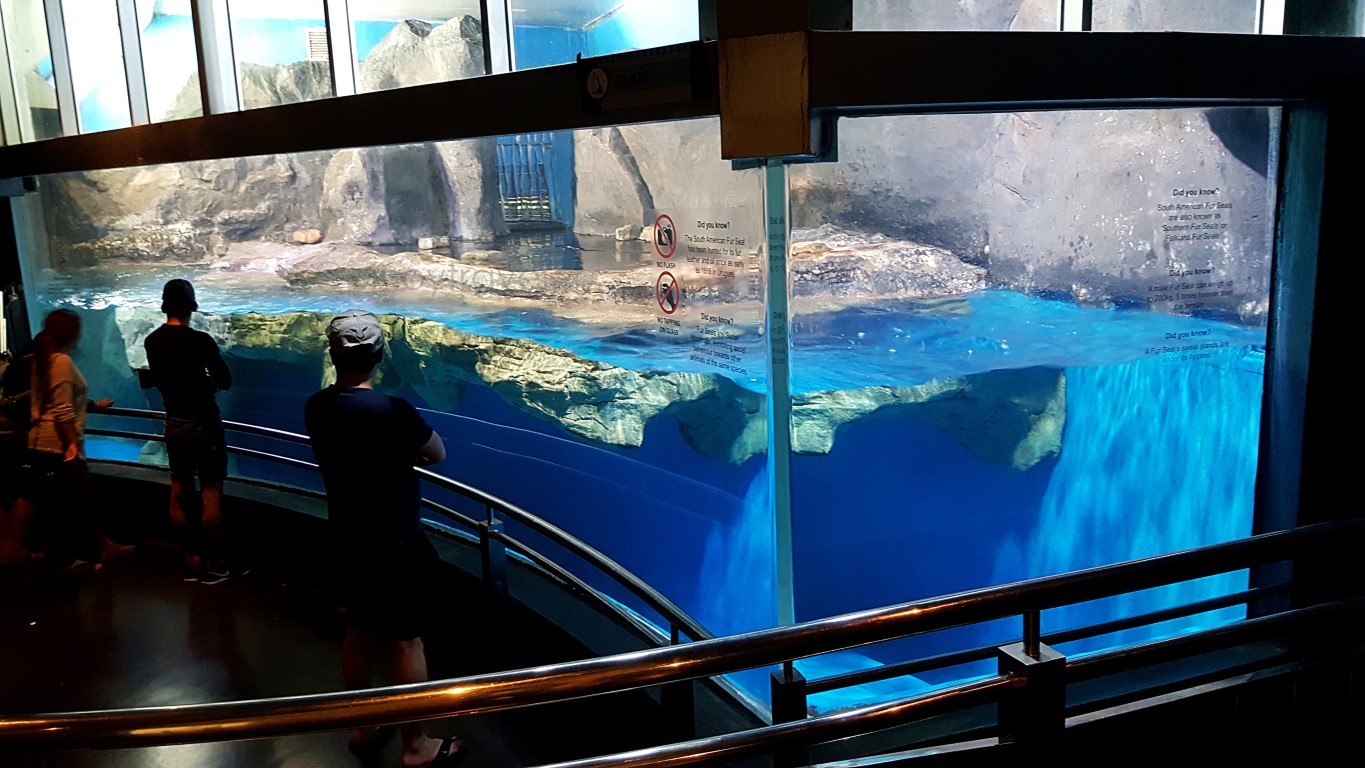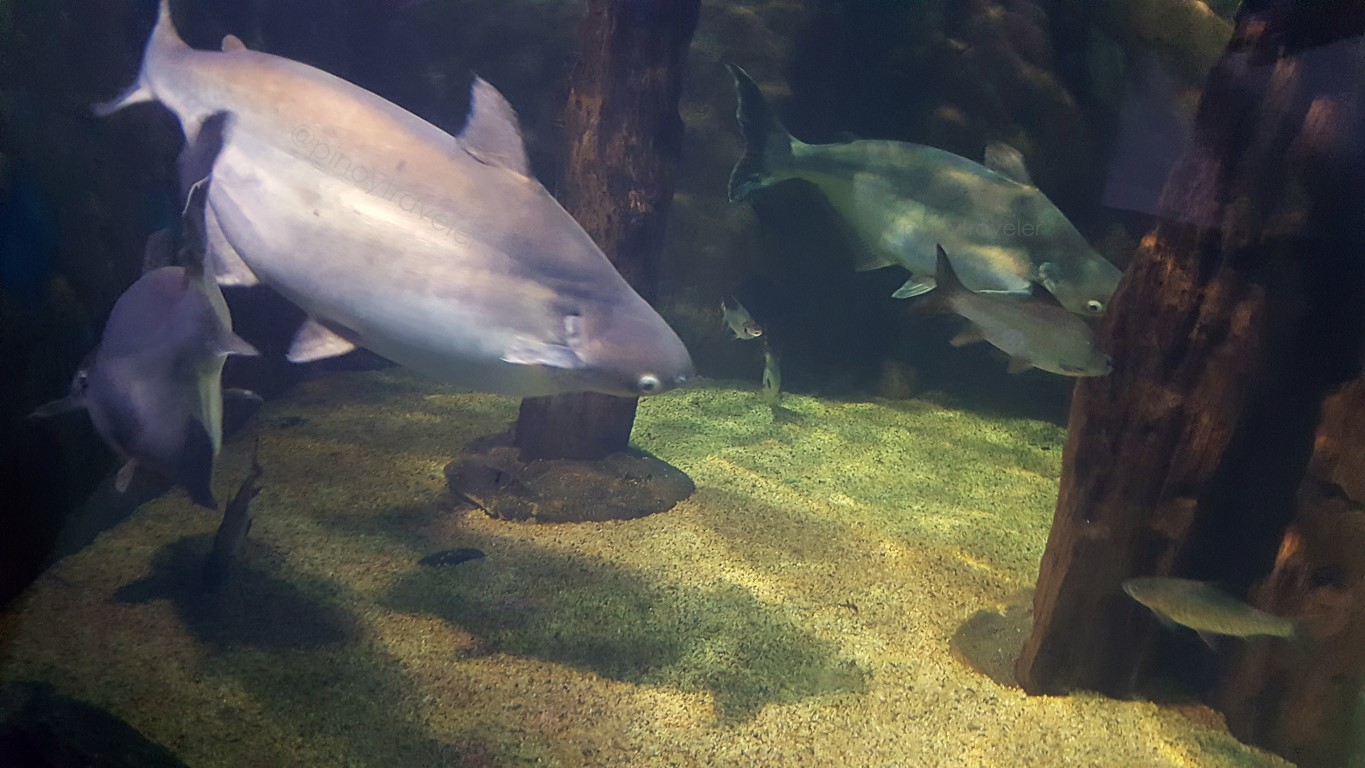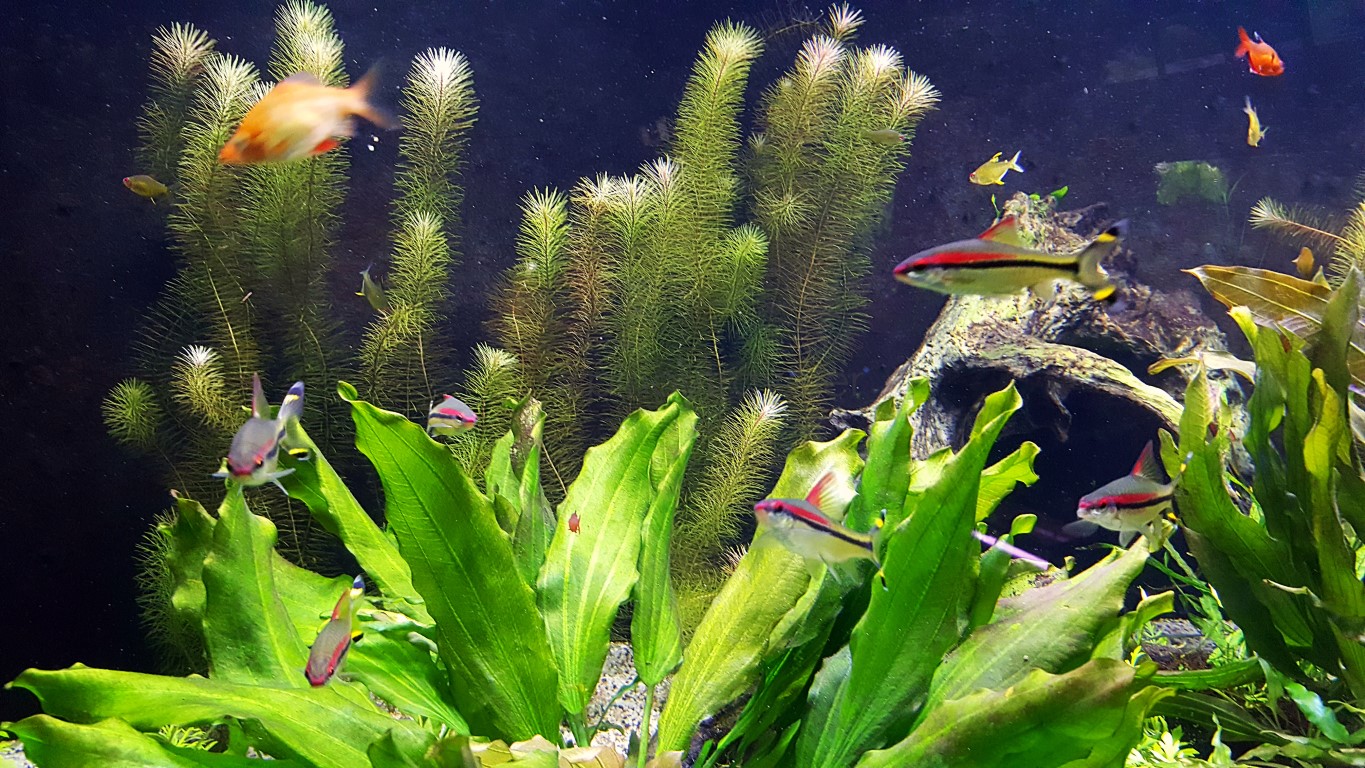Underwater World Langkawi
An educational and wonderful-enough place to visit in Langkawi, not only for kids, but even for adults! I visited it today, not on purpose as I didn't even know of its existence! I happened to be at the Cenang Beach area for a short meet-up with a client. We saw pics and signage at the entrance, so we went in!
What can I say.., ah ehh... first, it is not really literally 100% the "underwater" world. Many of the things to see are "on" or "above" the water.., but/which.., all the more makes this place a good way to explore, learn and appreciate the inter-related ecosystems of our planet. There are birds and animals in there!
Like these flamingos contentedly feeding on a makeshift river of a 'tropical rainforest'!
There's also this 'Proud Pheasant' (red arrow) that does not seem to know how to stop running!On the path, just past that plant in the middle of the photo, is another bird they call a Ruddy Shelduck.
There are other birds in that huge enclosure. I saw a Cockatoo and others just freely perched on some branches, or flying around in that aviary. There are lizards and snakes too. Even cute little marmosets!
But let's go see their creatures of the underworld... starting with these four big and long Garfish!
They are (endemically) found in the Americas and the Caribbean areas only. None in Southeast Asia!
So, did you see the four big garfish? Here o...
While this is smaller than S.E.A. Aquarium we visited sometime ago, the collection is "wow" enough!
I think this is even smaller than the Manila Ocean Park. But I like it that some of their display tanks are viewable from the outside areas. Creatures are easier to see, plus you get that realistic outdoorsy feel!
There is even this faux waterfall for that added realistic feel of the rivers and fresh water habitat!Actually, I noticed that many youngsters liked taking their 'selfies' with that 'waterfall' as background!
And there is even this solitary turtle just having its grand time wading and feeding near the 'waterfall'!Hmm, can you even see the turtle? It's that greenish thing in the middle of the photo. It's not a rock, it's a turtle! Its face, not seen, is to the boulder, but you should see its left-hind-leg extended out. Shy type!
Of course, there are those that must be indoors. Kept cool in fact. Like the first photo above and this:South American Fur Seals, a.k.a. Southern Fur Seals, a.k.a. Falklands Fur Seals. They're just adorable! They can be as long as 6 feet (six-footer!) and as the name suggests, only found in South America.
There are also African Penguins in another big glass-walled enclosure!Like the seals (above) these Penguins are not endemic to anywhere near Southeast Asia. They're only found in Africa's southwestern coast, specifically the countries of Namibia and South Africa. Thus it is good to see them live in our part of the world, especially since they're considered already endangered.
They are not the biggest of Penguins I have seen, probably just two feet in height, but I consider them "cute" and not intimidating. The fun(ny) thing is they don't sound like birds. Parang farm animals hehe!
If you can't see them in the picture above, try this.., I enlarged at least two of them..,
And then.., in another big enclosure.., there are the lovable Rockhopper Penguins. A crowd drawer!Yes of course, they are popular! They're easily identifiable with their distinctive "crown feather" colored black and yellow, and we've seen them on TV and in the movies! Who would forget Lovelace? Did you?
Here here.., same picture as above, I just magnified three of them!Movies aside, in real life, these penguins are especially appealing to children since they're rather small compared to other penguins. Rockhopper Penguins aren't even 2ft tall. Smaller than African Penguins.
I shot short video clips of those seals and penguins. Check this out!
Anyway and oh.., not everything in there are for the eyes. There are also 'attractions' for the stomach!
And yes, not all are things to see or eat, there are also techie things to indulge in!
But as the name of the place suggests, let's see more of the underwater world..,
Sea Anemone are colorfully beautiful, but deadly to some small creatures of the sea "w/ exceptions"!Clownfish have a symbiotic relationship with sea anemone. And if nemo is orange, there are some of them that are blue, black, red and whatever else! Parang sa tao rin, iba-ibang lahi o uri, iba-ibang kulay!
Hmm, I remember my high school biology, anemones are animals not plants, and they are predatory!
Many will cling/anchor themselves to some kind of 'base', while others can or may float for a time!
Some of them prefer to 'stand alone' while others can live in and around other creatures of the sea!
Starfish or Sea Stars aren't anemones, they are 'echinoderms'. Oh ha, parang balik-paaralan lang diba?But like us humans hehe, some starfish are more adventurous than others, or even 'pasaway', like that one above. Bored na yata siya sa sand, subukan naman ang feel ng glass! Walang basagan ng trip ha!
Btw, aside from clownfish (Nemo), there are shrimps, crabs and others that live with anemones.They don't get hurt by the anemone stinging cells. So, they hang around for protection from predators. Anemones in turn, benefit from their left overs or excretions. Scientists call it 'symbiotic relationship'.
"Symbiotic", dili "same bayotic".., pag-tarung Jill ha?!
Oh okay.., I also have video clips of those anemones and shrimps, even seagrass and small fish!
How about these? Yes plural, since there are two in the picture. Aren't they lovely?Actually there are even three of them, but the 3rd one is behind the white one. Charmingly adorable!
Thanks to aquariums like this one, we get to see how colorful it is down there, without diving!If I didn't see them here, I would find it hard to believe that yellow, black, red, green, pink, orange, blue, fuscha and more colors can exist in just one tiny little fish. They must be what are called rainbow fish!
Fortunately, I also have shot short video clips of the above kinds of fish!
Here are more of the shrimps. Well, I don't know how a cray, crayfish or crawfish differ from shrimps!Hahaha, when they look like shrimps, I just call them shrimps! I need to be further educated on this.
I do have a basis (ignorant as it may be) - if they're not as large as lobsters, I call them shrimp. Muna!They're fun to watch walking backwards! I realized, these "pasayan" also have multi-colored versions!
I also have videos of those "shrimps" just being themselves! Here here...
I think I already said this before..: moving (live) creatures are particularly hard to capture photographs or videos of. That is probably the reason I keep trying, so I will learn (even if the hard way) by trial-and-error. It's challenging (often frustrating). But when I get to capture one that I like, I feel so triumphant!That's an example of a pic I willingly "pat myself on the back" for, hehe! If you look in the middle, there is hardly a hint of water, until you realize there are the swimming blue fish! It's in an aquarium after all.
Look here.., same aquarium, same fish.., but I probably moved due to excitement. It came out blurry.Maybe I got overwhelmed when more of the blue fish came together. I probably tried a better vantage!
But they're part of the reasons why I love travel. I learn many things - not just knowledge but skills too!
For example, I have lately learned that 1) If I want fantstically memorable photos and/or videos during my travels, I should invest in a good camera. But, 1A: reality check, saan kukuha ng pang-invest? hehe, and 1B: good cams are usually cumbersome as they are heavy, and eat up too much backpack space!
Also learned that 2) with museums or oceanariums, most displays are glass-encased - glass reflects light (not just electric lights but even natural ambient light) to the lens, such that the photo gets ruined (e.g., photos of the arowana and giant gourami above). My ways around this issue, so far, are 2A: get as close to the glass as possible - kung pwede idikit ang lens sa glass!; 2B: change location or angle - at times a slight tilt is fine; and 2C: when all else fails, just give up, take notes and commit to memory!
I laugh at my self when I choose 2C, as I usually say "'tanginang kodak-kodak yan, nauubos oras ko"!
Anyway, some fish here are gold but very big unlike what we usually see in home aquariums. So are they also called goldfish? I must have read this tank's label, but I forgot what they are called.
Another crowd-drawer in this facility is this giant octopus - elusive and escape artist in real life!But thanks to Underwater World Langkawi, we are able to see them in a simulated habitat. I observed though, that octopuses (or this one, at least) don't only change colors when threatened or ambushing prey. It looked to me like it was not hunting, but it kept changing colors while roaming around its cage!
Maybe it also changes colors when having a good time or 'chillin out', di ba?! Here are some trivia..,And that 'bulletin board' is on a wall near the octopus display. Parang sa high school. But very useful!
Then there is this weird-looking one that looks like a cartoon character. MJ even said "pangit sya"!Well, I agree it looks weird. But I like its color and that moving 'hole' in front of its eyes. Ilong kaya yan?
And talking about weird underwater creatures, there are also these ones that literally have feet! The first one (pink) looks like a "butiki", the second (gold) looks like "palaka" to me hehe! Are they fish?
Ah, I also have videos of the above creatures, I'll put them here soon!
And there are many others more (pics and vids). I'll also add them soon.
Sharks, stingrays.., here are more creatures of the reef...
Meanwhile, let's go somewhere else!


















































Comments
Post a Comment